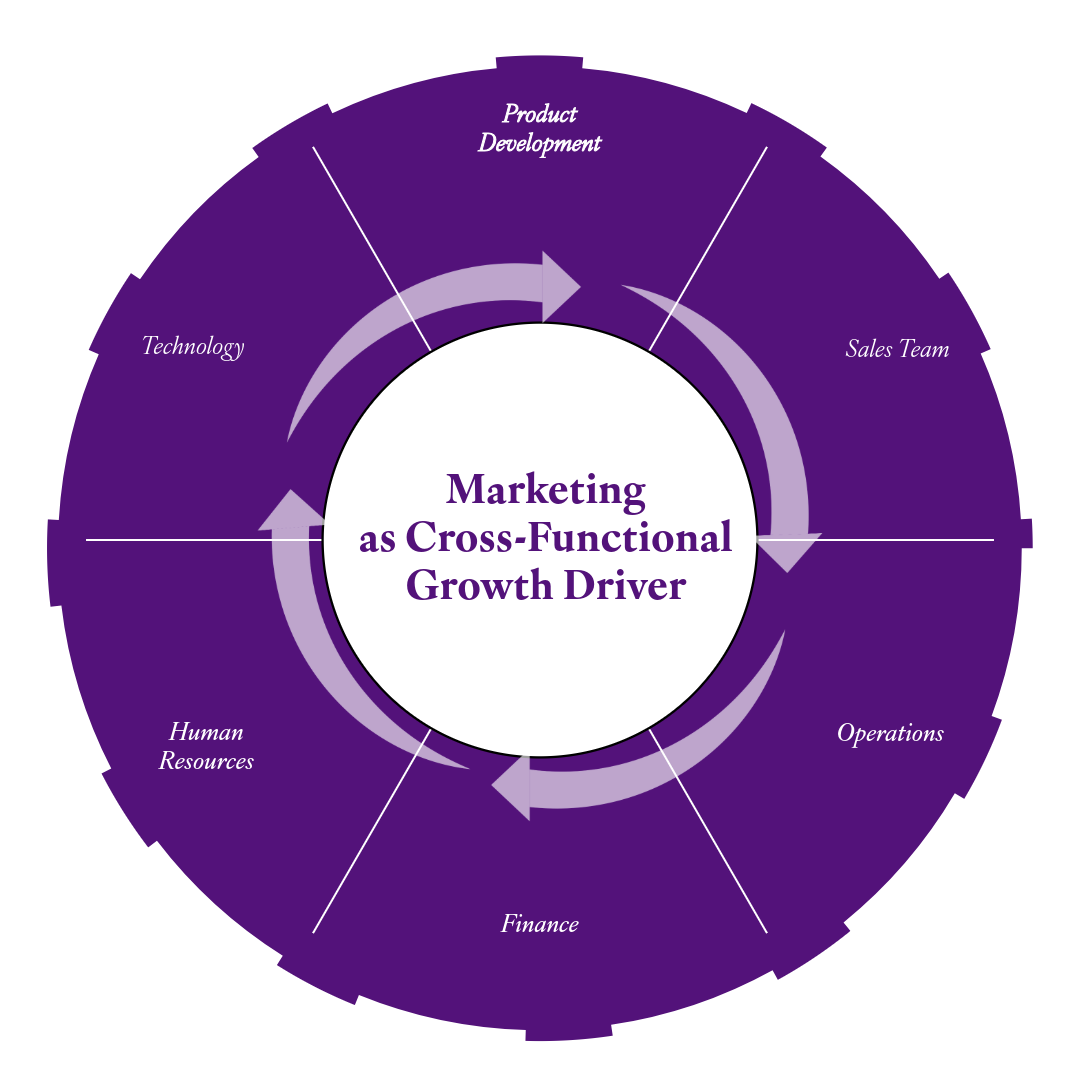The Foundation of Sustainable Growth – Reimagining Marketing as a Cross-Functional Force
{This is part one of our three-part blog series: The Growth Equation: Aligning Strategy, Story, and Systems for Lasting Impact. }
For many growth-stage businesses, marketing starts in silos: a bit of social media here, a product launch campaign there, some sales enablement thrown in. However, as a company grows, fragmented marketing starts to show its cracks. The message gets diluted. Teams pull in different directions. And customers feel the disconnect.
Integrated marketing offers a powerful shift from reactive tactics to aligned strategy, and more importantly, from marketing as a solo act to marketing as a cross-functional force for sustainable growth.
Sustainable growth happens when marketing aligns with every core function of the business—from operations to HR, product development to finance. That alignment allows businesses to scale with clarity, consistency, and resilience.
The Hidden Cost of Siloed Strategy
Siloed marketing can temporarily boost visibility, but it rarely supports sustainable growth. The problem lies in fragmentation: different departments use different messages, target different audiences, and run on different goals. It can result in:
Disjointed customer experiences where brand promises don’t match delivery
Inconsistent messaging that erodes trust
Inefficiencies from duplicated efforts or misaligned spend
Burnout and confusion among internal teams
Let’s take an example: Repurpose, a Los Angeles-based company that produces compostable home and kitchen products as alternatives to plastic. Founded in 2010, Repurpose has grown into a national brand with products in over 20,000 stores despite having a relatively small team of around 20 employees. Their success is rooted in a great product and a tightly integrated, purpose-driven strategy across all functions.
Product Development: Repurpose’s products are built on sustainability from the ground up, using plant-based materials. Their innovation process is informed by both market demand and the company’s mission.
Operations: The company has adopted AI-powered tools to streamline internal processes like vendor management and billing, cutting down on paper usage and reinforcing their eco-conscious brand values.
Finance: Automation supports financial accuracy and transparency. Marketing and finance work hand-in-hand to project campaign ROI and align spend with long-term revenue goals.
Marketing: Their messaging is deeply tied to their values and consistently shows up across packaging, advertising, and retail partnerships.
HR and Culture: Internally, Repurpose cultivates a purpose-driven culture where sustainability isn’t just a selling point—it’s part of daily operations, hiring, and employee engagement.
As a result, Repurpose has not only captured a significant share of the compostable tableware market—they’ve done so while maintaining brand integrity and growing sustainably. Read more about them here.
Integrated Marketing as the Bridge to Purpose and Performance
Marketing has the unique opportunity to bridge a company’s vision and day-to-day execution. It is, at its best, a translator of purpose—turning abstract mission statements into tangible brand experiences.
Marketing isn’t just a department- it’s a business driver.
Harmonious growth happens when your brand, business strategy, team scale together.
An integrated marketing strategy helps:
HR builds a culture that reflects the brand’s external promise. From job listings to onboarding to internal comms, the employee experience should reinforce what customers see and feel.
Product development to stay close to market needs. Marketing gathers insights, customer feedback, and competitive data that can influence smarter innovation.
Sales teams to deliver a seamless journey. Shared messaging, aligned content, and integrated campaigns make conversion smoother and more authentic.
Operations to align delivery with expectations. If marketing sets the promise, operations must fulfill it. Integrated strategies ensure both sides are in sync.
Finance to tie marketing strategy to financial outcomes. When finance and marketing collaborate, companies can:
Budget based on long-term brand value, not just quarterly campaign ROIs
Forecast revenue more accurately using insights from customer behavior and sales funnel trends
Invest in integrated campaigns that drive sustainable profitability, not just short-term traffic
For instance, when small business retailers evaluate a new retail expansion, marketing collaborates with finance to model the cost of in-store displays, promotional materials, and targeted campaigns. Meanwhile, operations ensure logistics are aligned, and product ensures packaging supports both brand storytelling and business goals. This synergy creates strategic momentum, not reactive momentum.
This isn’t theoretical. Consider a B2B SaaS company with 250 employees and $20M in annual revenue. If marketing promotes a message of "simplicity and speed," but onboarding takes weeks, and customer support is slow, the disconnect becomes a growth risk. A truly integrated marketing strategy would prompt coordination with ops and customer success to streamline those touchpoints and keep the brand promise intact. With finance involved, campaign spending and product packaging decisions could better reflect actual unit economics and lifetime value.
Ultimately, a brand isn’t just seen—it’s felt. Integrated marketing is the nervous system that ensures your entire organization responds with unity and clarity.
Why This Matters for Sustainable Growth
Sustainability in business growth means more than just hitting quarterly numbers. It means building systems, teams, and brand equity that endure over time. When marketing is integrated across departments, it becomes a tool for:
Consistent value creation across customer segments and journeys
Internal alignment that reduces friction and increases speed
Greater adaptability in the face of market changes or new opportunities
Financial resilience through wiser investment and revenue alignment
Instead of reacting to disconnected metrics, integrated teams can align behind shared objectives and KPIs: deeper customer relationships, employee satisfaction, long-term profitability, and brand loyalty.
Now is a good moment to pause and ask: Are your internal teams aligned on the same story you’re telling externally? Where are the disconnects? How often do marketing, HR, sales, product, operations, and finance collaborate on shared campaigns or initiatives? Invite your leadership team to explore what marketing is driving—and what it could be driving across the organization.
And if you're ready to explore what integrated, sustainable growth could look like for your business, let's talk. Beony specializes in helping growing organizations build alignment, clarity, and momentum across every touchpoint.

